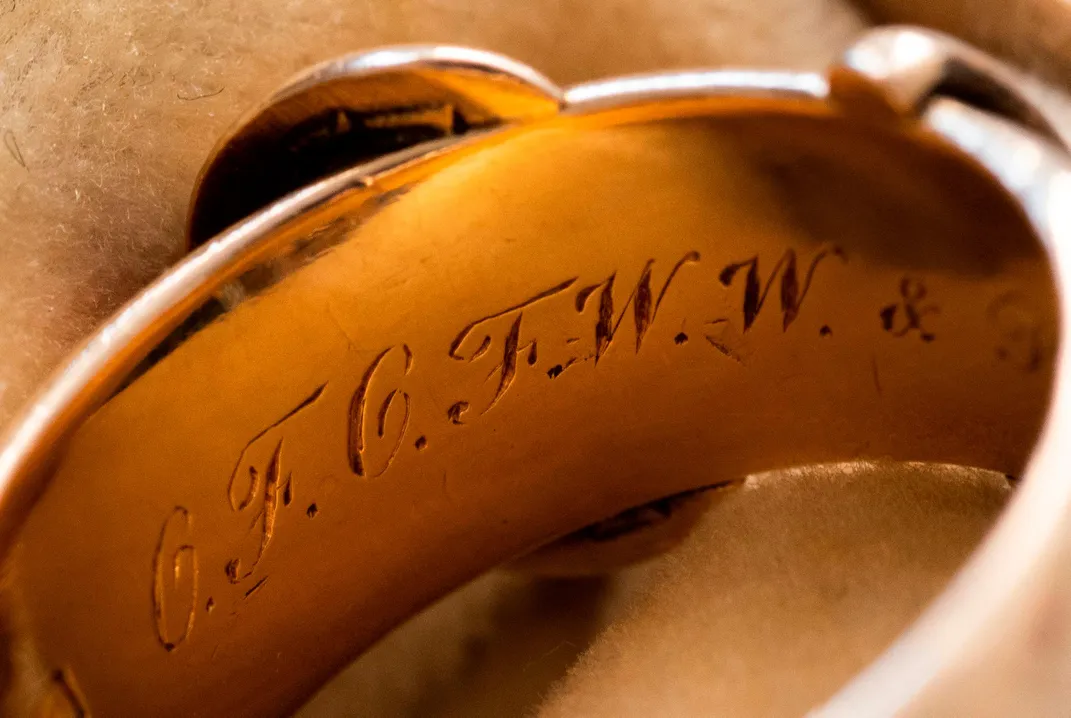Art Detective Tracks Down Oscar Wilde’s Stolen Friendship Ring
Authorities previously believed the ring, taken from Oxford in 2002, was melted down by an individual unaware of its true significance
/https://tf-cmsv2-smithsonianmag-media.s3.amazonaws.com/filer/1a/4a/1a4ac98e-1d77-4652-87e9-e53bf3d2bc54/gettyimages-1182753442.jpg)
A Dutch art detective has recovered an 18-karat gold ring gifted to a friend by Irish author Oscar Wilde 17 years after it was stolen from Oxford University’s Magdalen College.
As Agence France-Presse reports, Wilde and a friend named Reginald Harding presented the belt buckle-shaped ring to William Ward in 1876, when all three were studying at Oxford. A Greek inscription on the outer band translates to “Gift of love, to one who wishes love,” while a set of initials engraved on the inside of the ring hints at the trio’s identities: “OFOFWW”—short for the literary icon’s full name, Oscar Fingal O’Flahertie Wills Wilde—“+ RRH to WWW.”
Eamonn Andrews, a former cleaner and handyman at Magdalen College, stole the ring during a poorly executed May 2002 heist. According to the Oxford Mail, Andrews broke into the building via a skylight, then shifted his attention to the school’s Old Library, which houses an extensive collection of Wilde memorabilia. He fled with the ring—then valued at £35,000, or roughly $70,000 USD today—and three unrelated medals (a 1910 Henley Royal Regatta Grand Challenge Cup medal and silver and bronze medals dating to 1932) in tow.
DNA evidence found at the scene helped authorities trace the theft to Andrews, but they were too late to recover the trove of stolen objects; the burglar had already sold the gold ring to a scrap dealer for the paltry sum of £150, or around $300 USD today. As Mark Blandford-Baker of Magdalen College tells Reuters, authorities “thought it had probably been melted down by someone who did not realize its significance.”
The trail went cold until 2015, when Arthur Brand, dubbed the “Indiana Jones of the Art World” for his successful track record of solving high-profile art crimes (most recently, he tracked down a $28 million Picasso painting stolen from a yacht in 1999), heard rumors of an unusual Victorian ring’s appearance in London’s underground black market.
“I knew that Oscar Wilde’s ring was stolen from Magdalen College at Oxford and that it had a Greek inscription on it,” the self-described art detective tells AFP. “It could have only been the same ring.”

Per artnet News’ Brian Boucher, Brand suspects the ring’s re-emergence was tied to the Hatton Garden case, a brazen 2015 heist prosecutors called the “largest burglary in English history.” (During the robbery, a group of elderly thieves absconded with the contents of 73 safe deposit boxes; to date, authorities have only recovered a portion of the more than $20 million trove.)
As Brand explains to Boucher, rumors of the ring’s reappearance began circulating soon after the Hatton Garden heist.
“Of course no one is going to report those things to the police,” he says. “So we sent someone out there to investigate the aftermath of the heist, and that’s how we got to the person who bought the ring.”
The new owner “nearly had a heart attack when they realized it was Oscar Wilde’s ring,” Brand tells the Telegraph’s Brendan McFadden, and readily relinquished it into the art detective’s custody. According to AFP, the ring will be returned to Magdalen College in a small December 4 ceremony.
As the History Blog reports, Wilde, Harding and Ward were close friends during their time at Oxford, nicknaming each other “Hosky,” “Kitten” and “Bouncer,” respectively. Ward, a year older than Wilde, took the younger student under his wing and introduced him to his circle of friends. But in November 1876, Ward, unhappy with the scores he’d received on the term’s final exams, decided to leave the college and travel to Italy. Wilde and Harding presented him with the belt buckle ring—a traditional symbol of love or friendship—upon his departure.